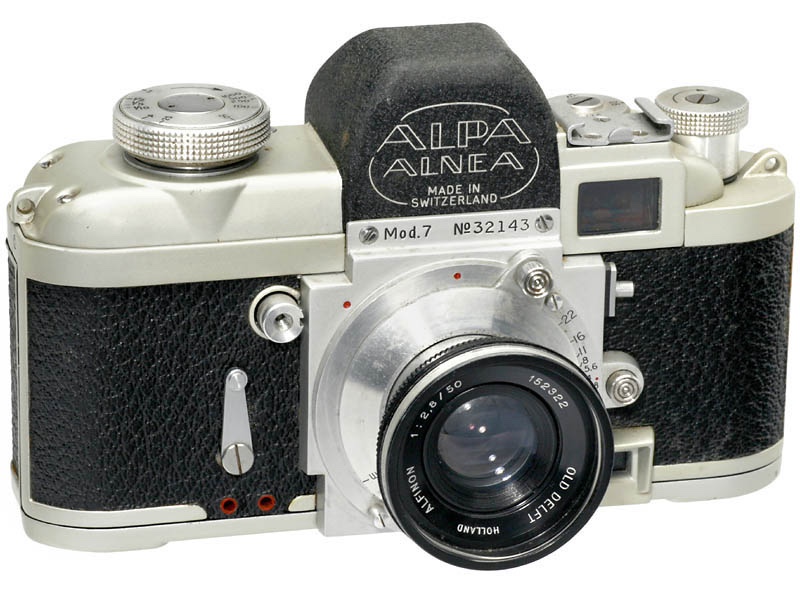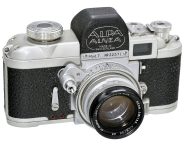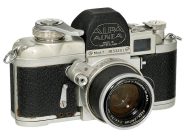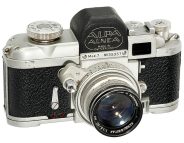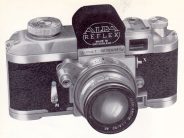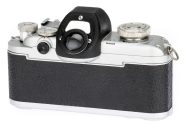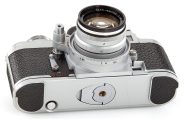Alpa Alnea 7
aka Alpa Reflex 7
35mm MF film SLR camera • Collectible
Specification
| Production details: | |
| Announced: | 1952 |
| Production type: | Small-batch production |
| System: | ● Alpa (1952) |
| Format: | |
| Maximum format: | 35mm full frame |
| Film type: | 135 cartridge-loaded film |
| Mount and Flange focal distance: | Alpa [37.8mm] |
| Shutter: | |
| Type: | Focal-plane |
| Model: | Mechanical |
| Speeds: | 1 - 1/1000 + B |
| Exposure: | |
| Exposure metering: | None |
| Exposure modes: | Manual |
| Physical characteristics: | |
| Weight: | 810g |
| Dimensions: | 149x88.9x101.6mm |
Manufacturer description #1
ALPA-ALNEA is the most complete and versatile 35 mm camera that really satisfies all wishes of the modern photographer.
The name ALNEA is significant! It means "all near." And in fact with the new ALPA ALNEA, even with the standard lens (Switar or Xenon 50 mm) and without any additional equipment, you can take pictures from infinity down to less than 2 feet. This corresponds to a reproduction scale of 1/9, which means that an enlargement of only 9 times produces a picture the actual size of the object.
Just remember, with the usual focusing down to 3 1/3 feet the reproduction scale achieved is only 1/17 of the natural size!
And this is but one of the many novel features of our new camera.
The wide range of interchangeable ALPA lenses includes any focal length for satisfying the special requirements of the advanced photographer amateur, professional or scientist. It opens up prospects of photography that can hardly be imagined. And it is so very simple! All that is necessary is to insert any of the lenses into the camera (with a single turn, thanks to the practical bayonet mount), and it is immediately ready for use. No problems of parallax, no additional view-finders or other accessories. The image produced by the lens is directly reflected on the ground-glass.
The new ALPA ALNEA has also the advantage of a shutter setting controlled by a single knob. The entire speed range from 1 sec. to 1/1000 sec. with any intermediate speed between calibrations can be set directly on the handy rim of the winding knob, whether the shutter is wound or not. Bulb exposure (at P) is also available, which may be used for Time with the aid of a cable release.
The same knob winds the shutter, advances the film and operates the counter - and all this with a rotation of only 160°, less than half a turn ! One glance at the knob indicates whether the shutter is wound or not.
ALPA Model 7 is fitted with a self-timer whose tension lever can be set to any desired time-lag up to 15 seconds. It should be mentioned that the self-timer is useful not merely for taking pictures of one's self, alone or in a group, but also for technical purposes. When a picture has to be taken under difficult conditions, for instance on a high scaffolding, the only way to operate the camera absolutely without vibration is by means of the self-timer.
Internal Synchronization is obtained in a practical and reliable manner by means of two sockets - one for flash-bulbs (with about 16 milli-seconds ignition delay) and the other for electronic speedlights (with zero delay). Flash-bulbs with a long peak for focal plane shutters can be synchronized for all speeds up to 1/1000 sec., whereas electronic speedlights must be used at 1/50 sec. or slower speeds (when the shutter opens completely). A socket located above the view-finder permits attaching the Metraphot Exposure Meter which can remain fitted on the camera in the ALPA Ever-Ready Case.
Loading and unloading the ALPA is done very easily and safely by removing the entire back. Any ordinary cartridge for 36, 20 or 18 exposures can be used as well as Karat cartridges. Access to the picture window is unhindered, which makes it very easy to clean the film track.
Instead of the scales showing film sensitivity or the like, which are often found confusing, the new ALPA ALNEA has a white plate located beside the reflex eye-piece, on which notations concerning the film in the camera can be written in pencil. Rub lightly with a damp finger to erase old notes and make room for new ones.
The ALPA Ever-Ready Case is sturdy and protects the camera completely without hindering its operation. It is designed in such a way that not only the standard 50 mm lenses, but also the interchangeable lenses of 38, 75 or 90 mm focal length can remain on the camera and still allow the case to be closed.
The 2 sunshades, A 42 ⌀ and B 52 ⌀ serve for the whole range of interchangeable lenses from 38 to 180 mm. They can be attached and removed in an instant and fit absolutely firmly. When not in use they can be placed upside down over the lens (except with the short 38 mm lens) and housed in the carrying case.
All ALPA filters are of superior optical quality (glass dyed in the mass) and coated. Like the sunshades they are available in two diameters serving all lenses up to 180 mm. Lenses of 300 rnm and longer focal length are supplied with a special filter set.
Every detail of the new ALPA ALNEA has been carefully studied and successfully tested.
Here are just a few examples to prove this claim:
1. The retractable 50 mm lenses can be pushed back into the ALPA at any time regardless of the position of the mirror, which is withdrawn automatically.
2. If the photographer forgets to pull the lens out, the shutter release requires such a strong pressure that wrong exposures are out of the question.
3. If the control knob is not completely wound (due to haste) the shutter can be released by pressing the button, but remains closed while moving, so that the partly transported film is not exposed. On rewinding once more only the supplementary part of film is advanced, thus eliminating wastage.
4. When using slow speeds or taking time exposures the mirror returns to the viewing position only after the shutter is closed again. The release button therefore does not have to be depressed longer than usual.
5. The partially coloured image produced by the range-finder disappears in the view-finder, when lenses of other than the standard focal length of 50 mm are fitted. Since only the standard lenses are coupled with the range-finder, the latter cannot be used incorrectly for focusing with lenses of other focal lengths.
***
HOW THE SUBJECT IS SEEN...
...through the combined Range/View-finder (ALPA ALNEA, Mod. 7)
A large, brilliant, sharply defined image, corresponding to the frame of the standard lens of 50 mm focal length. The combined Range and View-finder is located very close to the camera lens.
The complementary colouring of the centre field gives a strongly contrasted second image, so that for sharp focusing superimposition can be checked with maximum accuracy.
Since the base of the range-finder is arranged vertically, it is best to aim at horizontal lines or corners.
The view-finder can be adjusted to the frames corresponding to lenses of 90 and 135 mm focal length by simply turning a dial. It then serves only for viewing the subject, but is not coupled with the range-finder.
***
HOW THE SUBJECT IS SEEN...
...through the REFLEX PRISM (ALPA ALNEA, Models 7 and 5)
The image is directly focused exactly, as it will appear on the film, on a fullsize ground-glass of 23 x 35 mm. This corresponds to the size of the area left free by the projection mask - allowing 1 mm leeway in each direction compared with the negative of 24x36 mm.
Parallax is completely eliminated, because the ground-glass image is obtained through the picture taking lens, whatever its focal length. The unique 3-lens system gives so great a magnification that the image appears to the eye even larger.
Upright and correct left to right (reinverted), the ground-glass image is exceptionally brilliant and sharp, right up to the very corners. Sharpness of focus, composition and depth of field can be judged at one glance, even at small stops. Following fast moving objects is as easy as it can be. On pressing the release button the image disappears at the last split second only, to reappear as soon as the exposure is finished. This makes it far easier to remember the snapshots actually taken.
There is no better method of checking any type of picture and with any of the interchangeable lenses.
***
ALPA ALNEA, Model 7
The most perfect version of all ALPA Cameras.
Main features summarized in brief:
- Prism Reflex focusing: Ground-glass image, upright and correct left to right (reinverted).
- Individual Range-finder coupled with all standard lenses of 50 mm focal length.
- Multi-focal view-finder for 50, 90 and 135 mm lenses.
- Self-timer allowing up to 15 seconds time-lag.
With Switar or Xenon in special mount, permitting direct focusing to 1/9 actual size (down to less than 2 feet): 5 7/8 x 3 1/2 x 4", 28 3/5 oz.
With Alfinon in retractable mount and focusing down to 3 1/4 feet: 5 7/8 x 3 1/2 x 3 1/8", 26 1/3 oz.
Manufacturer description #2
The ALPA-REFLEX camera is available in three different models:
Model 7: The most perfect camera with prism-reflex focusing and individual coupled rangefinder. Combined with multifocal "sportstype" viewfinder. Selftimer.
Model 5: without coupled rangefinder, selftimer.
Model 4: direct reflex focusing, without prism.
General Notes: The ALPA-REFLEX is a camera which has been developed over a period of many years and - after having reached utmost perfection - is now built in series. Every detail has been carefully studied and decided upon judging from the practical point of view of the actual user of the camera, the PHOTOGRAPHER.
The camera body is made of lightmetal precision diecasting, thus guaranteeing a perfect and lasting stability. The entire metal surface is chromiumfinished - using a most modern process - which provides not only superior appearance but also an additional protection against corrosion. The camera body is covered with synthetic leather which is sweat, heat and water proof, i.e. much more durable than real leather.
All levers and knobs are easy to reach, attractively designed and above all they can be operated even when wearing heavy gloves. The camera has been made "foolproof", which prevents wrong manipulations as well as damages.
Manufacturer description #3
As a raw beginner, as an advanced amateur, as a professional, scientific or industrial photographer, you will find the ALPA the most complete, the most versatile, the most precise, the one and only All-in-One 35 mm camera. The ALPA will be your key to the door of a photographer's paradise, where you will fulfil your most cherished ambitions!
First revelation: The finest grain groundglass of your ALPA's single lens reflex system offers you a razorsharp, strikingly brilliant image, in lifesize and in all its natural colors. Your subject appears so surprisingly close and sharp that it gives the impression of jumping at you.
Second revelation: The single lens Reflex system of your ALPA provides critical through-the-lens focusing, without all the parallax problems encountered in twin-lens-reflex and rangefinder cameras.
Third revelation: Your ALPA's accurately framed groundglass image guarantees perfect composition with any lens, at any distance, at any magnification. No cutting off of heads or feet! This is especially important in color work, where later correction by trimming is impossible.
Fourth revelation: The unique advantage of viewing through your picture-taking lens ensures perfect depth of field control. You see the exact zone of sharpness in front of and behind your main subject, at any aperture: never a fuzzy foreground or background!
Fifth revelation: The precision-ground prism of your ALPA, set at an exclusive 45°, enables you to view with your head in a natural and comfortable position, without any strain. This angle is also ideal for close-up shots, copy work, photomicrography, overhead and low angle shots. And those who wear glasses can rest them right on the rubber eyepiece of the prism without danger of scratching the lenses.
Sixth revelation: The separate rangefinder of your ALPA 7 or the built-in rangefinder of your ALPA 6 allow you to doublecheck and pinpoint your groundglass focusing quickly and automatically.
Seventh revelation: Your ALPA's shutter speeds ranging from 1 sec. to 1/1000 - with intermediate speeds between calibrations - work accurately on a Swiss precision watch movement that is practically indestructible.
Eighth revelation: A complete range of rapidly and easily interchangeable ALPA lenses from 28 mm to 3750 mm supertelephoto, brings the widest possible variety of pictures within your scope: extreme and medium wide angles, normal snapshots, ultra close-ups, copy work, portraiture, medium range photos and far distant views.
Ninth revelation: Your ALPA apochromats are the only lenses that give you complete correction of all primary colors as well as critical sharpness and highest contrast, even at full aperture: ALPA-Kern Switar 50 mm f/1.8 Apochromat (Automatic Diaphragm) with 7 precision ground lens elements and ALPA-Kinoptik 100 mm f/2 Apochromat (Preset Diaphragm) with 6 precision ground lens elements.
Tenth revelation: The parallax-free single lens reflex system of your ALPA combined with the extreme extension range of the ALPA lenses, breaks through the notoriously difficult "iron curtain" at 1 yard distance and lets you focus as close as you wish. Thus, you can photograph a butterfly's wing, a colorful flower, an ancient coin, a confidential document, a rare stamp, etc. without additional reflex housings, sliding attachments and other "extras". You can record an object magnified up to 2x on your negative, i.e. before enlarging it.
Eleventh revelation: The unequalled versatility of your ALPA, relying on a minimum of accessories, also eliminates much of the expensive and complicated equipment previously, required for scientific and industrial photography, including microscopic photography. In surgery, ophthalmology, dentistry and other medical sciences; in chemical, textile, metal and other industries; in police, military, government and educational work, the ALPA has become an indispensable recording instrument of unparalleled precision and dependability, synonymous with progress.
Twelfth revelation: All ALPA optics and lenses have been selected to give you equipment of the finest optical quality. Each individual lens passes two rigid quality control tests - by the lens manufacturer and the ALPA factory - and carries an unconditional guarantee for highest optical performance.
***
The ALPA 7 solves the photographer's eternal dilemma: reflex camera or rangefinder camera. Its exclusive design combines both ways of focusing in one camera, offering you a single lens reflex system for groundglass viewing and focusing plus a separate, super-imposed rangefinder for rapid action shooting combined with a multifocal "sports type" viewfinder for previewing scenes.
The precision ground ALPA prism reinvents the large, unbelievably brilliant image on the groundglass. You can carefully study your subject, compose your picture with utmost ease and bring it into sharpest focus, having complete depth of field control, even under the most adverse lighting conditions. The ALPA's optical system is a miracle of luminosity, providing highest possible illumination even at small diaphragm stops.
The ALPA 7 (like all other ALPA models) is available with the unique Kern Switar 50 mm f/1.8 APOCHROMAT with fully automatic diaphragm, which permits you to view and focus at full aperture, but photograph at any smaller aperture. As you release the shutter, the diaphragm closes automatically to the preselected stop, then reopens automatically immediately after the exposure. This is an indispensable feature for photography under poor lighting conditions. The ALPA 7 has a built-in selftimer for up to 15 seconds delayed action, enabling you to take pictures of yourself. The selftimer may also be used in place of a cable release, for photographs which require complete freedom from vibration.
***
The unique features of the ALPA ALL-IN-ONE camera briefly summarized:
A. Single lens reflex system with parallax-free through-the-lens focusing - with any lens, at any distance, for any magnification.
*B. Separate, single window, coupled rangefinder for rapid action shooting (Mod. 7).
*C. Multifocal "sports type" viewfinder for fast previewing of scenes (Mod. 7).
*D. Split-image prism rangefinder - built right into the groundglass - for instantaneous and automatic pinpointing of focus (Mod. 6).
E. Precision-ground prism gives reinverted strikingly brilliant image, in lifesize and in all its natural colors.
*F. Logical 45° viewing angle permits natural head position, especially convenient for wearers of glasses.
*G. Finest grain groundglass guarantees absolutely critical focusing and depth of field control at any aperture.
H. Accurate framing of groundglass image provides utmost ease of composition for any type of photography, including close-up and copy work.
*I. One rim-set-knob sets all speeds and winds camera in less than half a turn (160°) - ideal for fast sequence work.
J. Exposure speeds: 1 second to 1/1000 second, B (T) and selftimer up to 15 seconds delay, with intermediate settings between speed marks.
*K. Neoprene-coated, internally synchronized, focal plane shutter operates smoothly and accurately on a Swiss precision watch movement, even at extreme temperatures.
*L. Rapid gear mechanism speeds rewinding of exposed film for quick film change.
M. Reflex mirror flips up smoothly without vibration, returns to viewing position automatically immediately after exposure.
N. ALPA Clickstop lenses are of finest optical quality and coated - range from 28 mm wide angle to 3750 mm super telephoto.
*O. ALPA APOCHROMATS: Kern Switar 50 mm f/1.8 APOCHROMAT and Kinoptik 100 mm f/2 APOCHROMAT give exclusive correction of all primary colors, critical sharpness and highest contrast, even at full aperture.
P. ALPA All-in-one lenses: ALPA Makro-Kilar 40 mm f/2.8 focuses continuously from infinity down to 4" or 2", ALPA Makro-Kilar 90 mm f/2.8 from infinity to 8", without accessories!
*Q. ALPA lenses have extra long extensions, provide a continuous focusing range all the way down to ultra close-ups - ideal for scientific and industrial macrophotography.
*R. Automatic diaphragms, requiring minimum pressure, and extremely lightweight lens mounts permit handheld pictures, even with telephoto lenses at slow speeds.
*S. 100% lens consistency: Every single ALPA lens undergoes two scrupulous quality control tests - by the lens manufacturer and in the ALPA factory - and carries an unconditional guarantee for highest optical performance.
*T. Slip-in ALPA filters are made of finest optical glass dyed in the mass, plane parallel and coated.
*U. ALPA Macrostat copy and close-up stand, suitable for both indoor and outdoor use, is extremely lightweight and may be carried in an ordinary briefcase.
V. Microscopic photography: One 2-piece adapter ring attaches the ALPA to any microscope.
*W. ALPA All-in-one ever-ready case holds the ALPA with wide-angle, 50, 75, or 90 mm (!) lens plus lens shade, filters and exposure meter.
X. ALPA-Omnica de luxe gadget bag holds ALPA plus up to 6 ALPA lenses and most ALPA accessories.
*Y. Well balanced design: The ALPA weighs but 21 ounces and is exceptionally compact: 5 7/8" x 3 1/2" x 3 1/8".
*Z. A custom-built camera: Each ALPA is painstakingly assembled like a fine Swiss watch - a high precision instrument of extreme sturdiness.
* Exclusive ALPA feature.
